ASUS G74SX: Noteworthy Updates to ASUS' G7 Series
by Jarred Walton on October 6, 2011 12:00 AM ESTSystem Temperatures and Noise Levels
One area where I’ve praised the ASUS G73 in the past is their thermals and noise levels. The G74SX continues that reputation, providing an extremely quiet notebook even during lengthy gaming sessions. Idle noise levels fail to register above the ~30dB noise floor of my testing equipment and environment, and under maximum load the G74SX still only hits 37.3dB. Of course, noise is only half the equation—is ASUS just running their fans at low RPMs to keep things quiet while letting the internal components roast? Here’s a chart showing maximum temperatures as reported by HWMonitor after several hours of running high load tasks (Cinebench, x264 encoding, gaming, 3DMark looping, and even 3DMark looping while Cinebench renders in the background).
Compared to the noise created by Clevo gaming notebooks and other offerings like MSI’s GT680R, the ASUS G7 series delivers the goods in cooling and keeping quiet. In our stress testing, the CPU maxed out at a comfortable 76C, while the GTX 560M laughs as it fans itself lightly with a 65C core temperature. That makes the CPU temperatures roughly the same as the G73, while GPU temperatures have dropped 10C—apparently the reworking of the internals paid off handsomely.
I do have a concern over whether the G74SX can handle extreme environments—like say a soldier wants to pack one of these over to the Middle East during the summer months. To see if the fan speeds normally experienced are the maximum ASUS supports or if the system just isn’t getting hot enough to ramp up the RPMs, I put my hand over the rear vent while running 3DMark06. Naturally, temperatures started to climb, but unfortunately I can’t say the same for the fan RPMs. Noise levels remained consistent throughout the approximately 10 minute test run, and the GPU did manage to get up to 75C according to HWMonitor. That’s still 8C below what Dustin measured on the Alienware M18x, but it was painfully hot on my arm/hand. (Honestly, I’m surprised the GPU and CPU didn’t get any hotter!) The final score also dropped slightly (to 15241), but I’m not sure if that was a decrease caused by heat or if the new (beta) drivers are to blame.
While the above scenario may not be a fair test, I do wish ASUS had at least one higher fan speed available, and with a maximum load of Cinebench + 3DMark06 there did appear to be some throttling going on—again, though, only when I covered the exhaust vent, which isn’t something I’d recommend doing. The lack of a higher (and noisier) fan speed may also be why ASUS limits the G74SX to the GTX 560M. The GTX 570M and GTX 580M would likely need better cooling, and ASUS may not be willing to sacrifice noise levels in order to support such GPUs.
Update: A reader pointed out a potential CPU throttling issue in the comments, and I was able to replicate the throttling. The throttling so far required the use of Furmark along with a heavily threaded CPU workload, at which point the CPU clock drops to 800MHz and stays there until Furmark is halted (or the CPU load is removed). The temperatures are not a problem, and without using Furmark I have not been able to cause CPU throttling, but the potential is at least there. If anyone has other specific workloads not involving Furmarm (or a similar utility, e.g. MSI Kombustor), please let me know and I will investigate further.
Still a Good LCD
The G73 notebook had a good LCD, with a high contrast and reasonable color. My one complaint was that even at maximum intensity, the backlight wasn’t as bright as I would like. With the G74SX, ASUS appears to have taken that criticism to heart, as the maximum brightness is nearly double that of its predecessor.
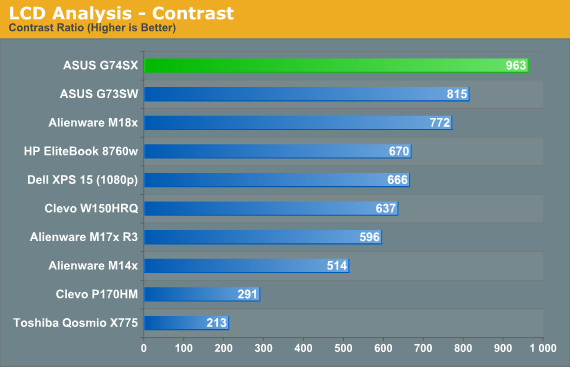
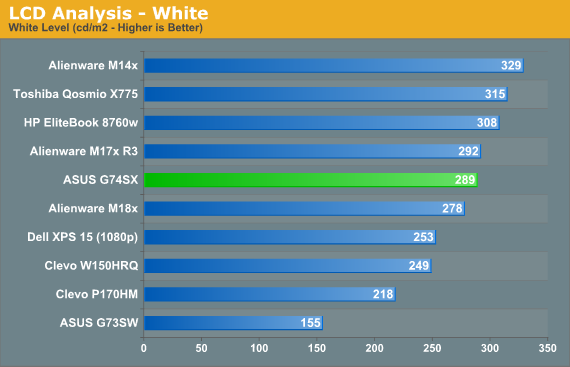
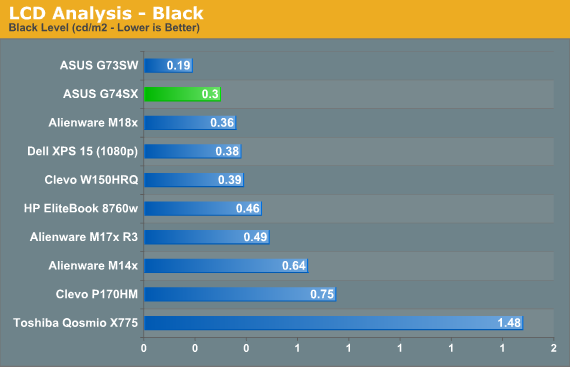
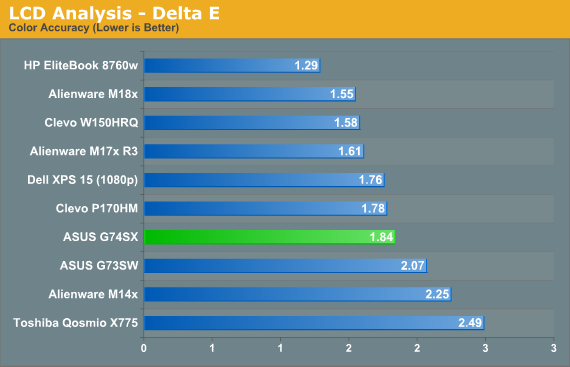
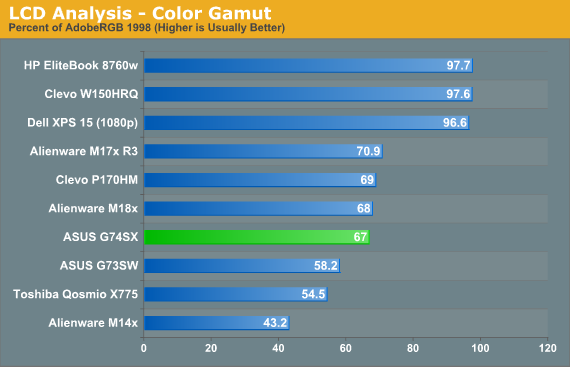
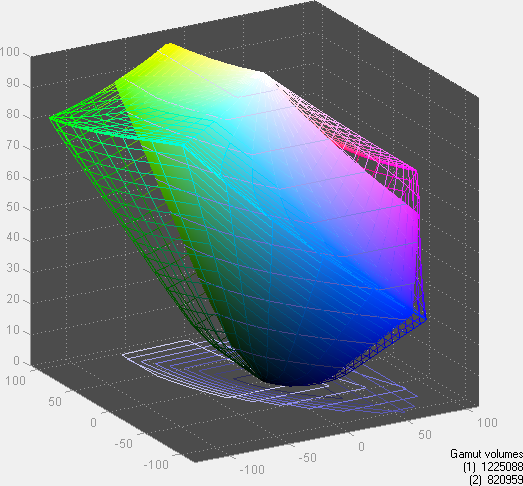
Contrast is excellent at nearly 1000:1, and the maximum white level of 289 nits is a big step up from the ~150 nits of the G73 series. Given the change in characteristics, it’s no surprise that the LCD panel used in the G74SX is different this round, coming from Chimei Innolux (instead of HannStar). The model is N173HGE-L21, and it appears that our contrast ratio result is better than the advertised 500:1. Backlight intensity is up, and we also note that color gamut is up, with a slight (not generally noticeable) improvement in color accuracy as well. Without calibration, the panel has a decidedly bluish cast, but that’s common among LED backlit panels. Overall, I definitely appreciate the changes made to the LCD panel; the previous version was good, but the new version matches or improves on it in virtually every way.
We’re still dealing with a TN panel, so viewing angles aren’t perfect, but they’re about as good as you can expect from the technology. I still wish the notebook people would start using IPS panels in laptops—they’re putting them in $400 tablets after all, so it can’t be that hard to fit one into the budget of a $1500+ notebook, can it? Then again, supply and demand create a self-perpetuating cycle, so as demand dries up so does supply, resulting in higher prices for the remaining supply, which segues back into lowered demand, etc. I’d love to see that trend reverse and go the other way.


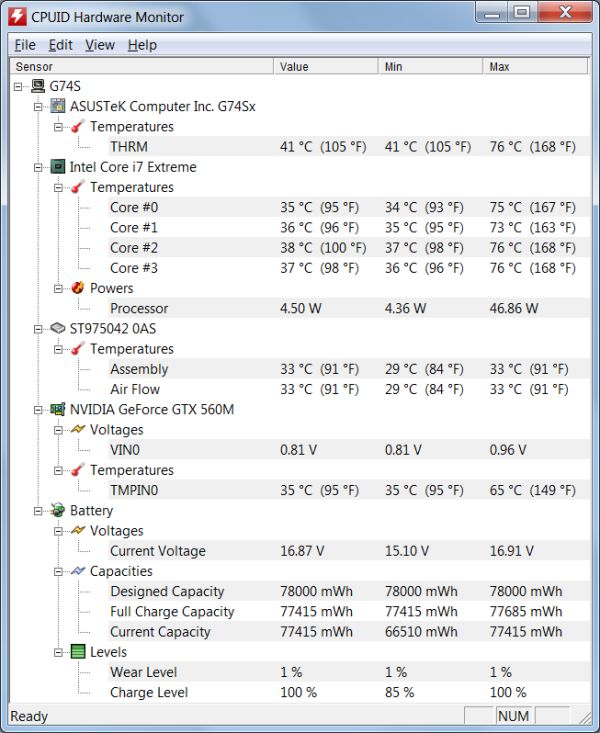













44 Comments
View All Comments
seapeople - Friday, October 7, 2011 - link
Don't say things like that, because soon we'll be hearing from the "I have 32GB of RAM and it's not enough for my super duper special application load" crowd.JojoKracko - Tuesday, October 11, 2011 - link
He is saying 8GB because the 16GB is useless for the rest of the computer's specs. It is just a waste. Cheap marketing poop.DanNeely - Thursday, October 6, 2011 - link
The table at the start of the review indicates a HannStar panel, the LCD page says it's a Chimei Innolux.Joehettinger - Thursday, October 6, 2011 - link
I have a G73, and slapped a WD 128 GB SSD in it, the only problem I had was the lack of brackets and the weak chip-set limited me to 150 Mb transfers from the drive. It's good to see that they upgraded the chip-set so that the SSD can run at full speed.Also, the little rubber foot pads came off the first week or two. Anyone else have that problem? Did ASUS come up with a better way to mount the foot pads.
I'm also voting for the 16:10, I would love to have more vertical space.
And finally, A USB 3.0 port ... Outstanding!
andrewcooke - Thursday, October 6, 2011 - link
is there any site that provides a simple overview of the different asus models and their specs? the asus site is a real mess and doesn't explain anything unless you look in detail at each model. thanks.Wolfpup - Friday, October 7, 2011 - link
Not that I know of, but there's not that much variation. Basically the biggest change is the Best Buy model "only" has a 128-bit memory interface for the video RAM rather than the 192-bit interface on the other models (but it's also cheapest).Besides that you've got some variation in whether there's 1 or 2 drives (and thus a second drive bracket and cable), Blu Ray, and apperently this A2 model "only" has 1.5GB video RAM instead of 3GB like on most. (The ones with 2GB you know have a 128-bit memory interface because 192-bit ends up needing either 1.5 or 3GB to do that.)
Obviously Blu Ray is a must have, and I wanted the kit for the second hard drive, so the A1 model worked well for me, though frankly even the Best Buy model's a good deal, relative to a lot of other systems.
andrewcooke - Sunday, October 9, 2011 - link
hey, thanks for the reply, but i didn't mean just for this model, but for all asus laptops. i live outside the usa so need to select from info on the net (and then quickly buy something when i travel there). cheers.JojoKracko - Tuesday, October 11, 2011 - link
Search for G74 pdfI came across a pdf once that listed all of the specs for the many, many world wide variations of G74s. I think it was some Montreal computer shop, but it was in English.
Death666Angel - Thursday, October 6, 2011 - link
If I were in the market for such a notebook (read: desktop replacement with gaming capabilities), this would probably be it. Nicely balanced components, good looks, priced adequately.Paedric - Thursday, October 6, 2011 - link
I'm the owner of an original g73jh with an amd 5870, and there are several long term issue with.First, amd drivers cause screens of death, asus recommend the stock drivers.
That'd be fine if the latest version wasn't nearly 2 years old.
A common issue is the thermal paste of the gpu.
After some time, it needs to be changed, otherwise the gpu idles at about 80C and get as hot as 110C, before the system shuts down.
I don't know if the g series is still having those issues since it's not the same gpu anymore, but it has kinda ruined an awsome laptop for me.